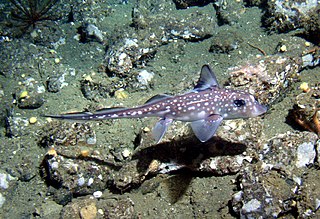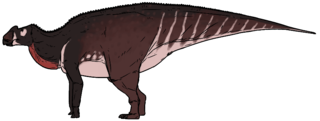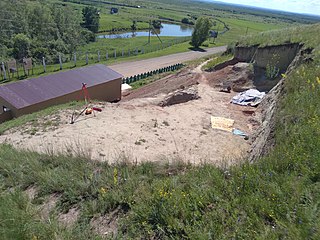Related Research Articles

Chimaeras are cartilaginous fish in the order Chimaeriformes, known informally as ghost sharks, rat fish, spookfish, or rabbit fish; the last three names are not to be confused with rattails, Opisthoproctidae, or Siganidae, respectively.

Richardoestesia is a morphogenus of theropod dinosaur teeth, originally described from the Late Cretaceous of what is now Canada, the United States and Kazakhstan. It currently contains two species, R. gilmorei and R. isosceles, and a possible third, R. asiatica. It has been used as a morphotaxon to describe other theropod teeth widely displaced in time and space from the type species. If all teeth assigned to the genus are truly reflective of the animals biology and taxonomic state, it would have been one of the longest lasting dinosaur genera, perhaps also being the most widely distributed.

Aralosaurus was a genus of hadrosaurid dinosaur that lived during the Late Cretaceous in what is now Kazakhstan. It is known only by a posterior half of a skull and some post-cranial bones found in the Bostobe Formation in rocks dated from the Upper Santonian-Lower Campanian boundary, at about 83.6 Ma. Only one species is known, Aralosaurus tuberiferus, described by Anatoly Konstantinovich Rozhdestvensky in 1968. The genus name means Aral Sea lizard, because it was found to the northeast of the Aral Sea. The specific epithet tuberiferus means bearing a tuber because the posterior part of the nasal bone rises sharply in front of the orbits like an outgrowth. Aralosaurus was originally reconstituted with a nasal arch similar to that of North American Kritosaurus. For many years, Aralosaurus was thus placed in the clade of the Hadrosaurinae. This classification was invalidated in 2004, following the re-examination of the skull of the animal which allowed to identify in Aralosaurus many typical characters of Lambeosaurinae. In particular, this study revealed that Aralosaurus had a hollow bony structure located far in front of the orbits, which communicated with the respiratory tract. This structure being broken at its base, its shape and size remains undetermined. More recently, Aralosaurus has been identified as the most basal Lambeosaurinae, and placed with its close relative Canardia from the upper Maastrichtian of France in the new clade of Aralosaurini.
Asiamericana is a dubious genus of coelurosaur known only from isolated teeth found in the Bissekty Formation of Kazakhstan. It was named to recognize the occurrence of similar fossil teeth in Central Asia and North America. These regions once formed a connected land mass, during the Cretaceous period.

Ischyodus is an extinct genus of chimaera. It is the most diverse and long-lived chimaera genus, with over 39 species found worldwide spanning over 140 million years from the Middle Jurassic to the Miocene. Complete specimens of I. quenstedti from the Late Jurassic of Germany most closely resemble the genus Callorhinchus amongst living chimaera genera. It is sometimes placed in the "Edaphodontidae", a unclearly defined group of chimaera with an uncertain position within the clade, while other authors place it into Callorhinchidae along with Callorhinchus.

Protostega is an extinct genus of sea turtle containing a single species, Protostega gigas. Its fossil remains have been found in the Smoky Hill Chalk formation of western Kansas, time-equivalent beds of the Mooreville Chalk Formation of Alabama and Campanian beds of the Rybushka Formation. Fossil specimens of this species were first collected in 1871, and named by Edward Drinker Cope in 1872. With a total length of 3.9 metres (13 ft), it is the second-largest sea turtle that ever lived, second only to the giant Archelon, and one of the three largest turtle of all time along Archelon and Gigantatypus.
Bogolubovia is a genus of pterosaur from the Upper Cretaceous Rybushka Formation of Petrovsk, Saratov Oblast, Russia. It is named for Nikolai Nikolaevich Bogolubov, the paleontologist who discovered the remains in 1914. It was in 1991 assigned to the Azhdarchidae. Wellnhofer (1991) however, retained it in the Pteranodontidae. Bogolubov had initially assigned the specimen, consisting of a single partial large cervical vertebra, as a new species of Ornithostoma, O. orientalis. It was later reclassified as a species of Pteranodon, before being assigned its own genus by Lev Nesov and Alexander Yarkov in 1989. The holotype has probably been lost, but other partial remains have been referred to the genus.
Edaphodon was a fish genus of the family Callorhinchidae. As a member of the Chimaeriformes, Edaphodon was a type of rabbitfish, a cartilaginous fish related to sharks and rays. The genus appeared in the Aptian age of the Lower Cretaceous and vanished in the Pliocene. It was most prominent during the Late Cretaceous. Many Edaphodon species were found in the Northern Hemisphere, but species from the Southern Hemisphere are also known.

Hydrolagus is a genus of fish in the family Chimaeridae found in the Atlantic, Indian and Pacific Oceans.
Gobiconodon is an extinct genus of carnivorous mammals belonging to the family Gobiconodontidae. Undisputed records of Gobiconodon are restricted to the Early Cretaceous of Asia and North America, but isolated teeth attributed to the genus have also been described from formations in England and Morocco dating as far back as the Middle Jurassic. Species of Gobiconodon varied considerably in size, with G. ostromi, one of the larger species, being around the size of a modern Virginia opossum. Like other gobiconodontids, it possessed several speciations towards carnivory, such as shearing molariform teeth, large canine-like incisors and powerful jaw and forelimb musculature, indicating that it probably fed on vertebrate prey. Unusually among predatory mammals and other eutriconodonts, the lower canines were vestigial, with the first lower incisor pair having become massive and canine-like. Like the larger Repenomamus there might be some evidence of scavenging.

Nannopterygius is an extinct genus of ophthalmosaurid ichthyosaur that lived during the Middle Jurassic to the Early Cretaceous. Fossils are known from England, Kazakhstan, Russia, and Norway and six species are currently assigned to the genus.

Volgadraco is a genus of pterodactyloid pterosaur from the Upper Cretaceous of European Russia. Volgadraco was originally classified as an azhdarchid. However, recent studies have concluded that it may belong to either the family Nyctosauridae, or the family Pteranodontidae.

Chimaera is the type genus of the cartilaginous fish family Chimaeridae.
The Bissekty Formation is a geologic formation and Lagerstätte which crops out in the Kyzyl Kum desert of Uzbekistan, and dates to the Late Cretaceous Period. Laid down in the mid to late Turonian, it is dated to about 92 to 90 Ma.

The Ilek Formation is a Lower Cretaceous geologic formation in Western Siberia. Many different fossils have been recovered from the formation. It overlies the Late Jurassic Tyazhin Formation and underlies the Albian Kiya Formation.
The Rybushka Formation is a Campanian geologic formation in the Penza and Saratov Oblasts of European Russia. Pterosaur, fish and invertebrate fossils have been recovered from the formation.
This list of fossil fishes described in 2017 is a list of new taxa of jawless vertebrates, placoderms, acanthodians, fossil cartilaginous fishes, bony fishes and other fishes of every kind that are scheduled to be described during the year 2017, as well as other significant discoveries and events related to paleontology of fishes that are scheduled to occur in the year 2017. The list only includes taxa at the level of genus or species.
Abdarainurus is a genus of titanosaur dinosaur from the Alagteeg Formation in Mongolia. The type and only species is A. barsboldi. Currently seen as an indeterminate titanosaur, it may represent a previously unknown lineage of Asian macronarians. Abdarainurus is not known from many remains; it is only known from eight front tail vertebrae and a middle tail vertebra and several chevrons.

Kansaignathus is an extinct genus of dromaeosaurid theropod from the Late Cretaceous Yalovach Formation of Tajikistan. The genus contains only one species, the type species, K. sogdianus. The generic name of Kansaignathus comes from near the town of Konsoy where it was discovered and the Greek word "gnathos" meaning "jaw". The specific epithet "sogdianus" is derived from the historical region of Sogdiana, which was an ancient name for the Fergana Valley region where the fossil was discovered. Kansaignathus is known from a single right dentary bone and a few post-cranial bone fragments. It was the first, and so far the only, dinosaur from Tajikistan to be described and named.

Coccolepididae is an extinct family of ray-finned fish, known from the Early Jurassic to Early Cretaceous, most of which were originally referred to the type genus Coccolepis. They had a widespread distribution, being found in North and South America, Australia, Asia and Europe. They are mostly known from freshwater environments, though several species have been found in marine environments. They are morphologically conservative, and have poorly ossified endo and exoskeletons, which usually results in poor preservation. This makes it difficult to distinguish species. They are generally small fish, with the largest known specimens reaching a length of 210 mm. Historically, they have been classified as members of “Palaeonisciformes”, a paraphyletic grouping of non-neopterygian fish, due to their plesiomorphic conservative morphology closely resembling those of many other groups of primitive fish. They have been suggested to be relatives of the Acipenseriformes within the Chondrostei.
References
- ↑ Ganodus, C. (1995). A new species of chimaeroid fish from the Upper Cretaceous of the Saratov region, Russia. Palaeontology, 38(Part 3), 659-664.
- ↑ Ward, D. J. (1973). The English Palaeogene chimaeroid fishes. Proceedings of the Geologists' Association, 84(3), 315-330.
- ↑ Averianov, A. O., and E. V. Popov. 1995. A new species of chimaeroid fish from the Upper Cretaceous of the Saratov region, Russia. Palaeontology 38:659–664.
- ↑ Popov, Evgeny V.; Johns, Marjorie J.; Suntok, Stephen (2020-01-02). "A New Genus of Chimaerid Fish (Holocephali, Chimaeridae) from the Upper Oligocene Sooke Formation of British Columbia, Canada" . Journal of Vertebrate Paleontology. 40 (1): e1772275. doi:10.1080/02724634.2020.1772275. ISSN 0272-4634. S2CID 221751740.